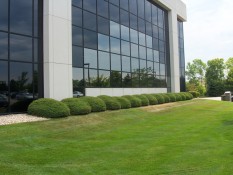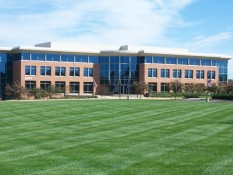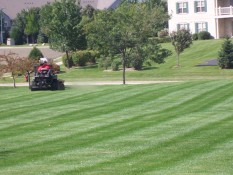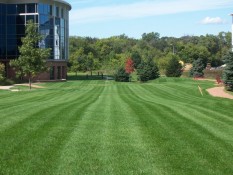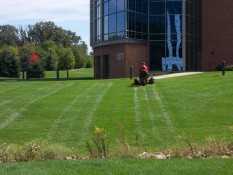Fertilizer and Weed Control Services
A healthy, beautiful lawn is one of the most important things a homeowner can do for the quality of our environment. A healthy, vigorous lawn reduces storm water runoff into our lakes. At Barnes, we focus on prescribing what your lawn needs and recommending proper cultural practices such as mowing and watering correctly, to help achieve those results.
Our agronomists and state certified applicators are well trained and only recommend services that your lawn only needs. Some of the services offered:
- Barnes’ 4-Step Program
- Lawn aeration
- Lawn dethatching
- Tree & shrub insect & disease control programs
- Tree & shrub pest diagnosis and hazard assessment
Lawn Aeration
Many urban soils, which were once rich farmland, have been stripped of their valuable topsoil and replaced with heavy, unfertile clay. This type of soil often is not conducive to growing healthy, thick turf. Clay soils can become easily compacted, impeding the movement of water and nutrients throughout the root zone, causing poor root growth and as a result premature drought stress.
If your lawn is or has been over-fertilized, the thatch layer can become too thick. Thatch is caused by the buildup of dead and undecayed organic matter in your turf. Too much thatch impedes the movement of water and nutrients throughout the root zone.
Furthermore, thatch provides a favorable environment for devastating turf insects and diseases to thrive.
At Barnes, Inc., we recommend doing a core aeration at least every other year, unless your lawn is newly sodded. We then recommend doing this annually for at least 3 years, then at least every other year after that. Early spring and fall are the best times to aerate because the turf is actively growing.
A way to combat these problems is with regular core aeration. A core aeration pulls “cores” of soil out of your turf and deposits them on top of the thatch layer. The natural soil microbes, which feed on thatch, are forced to feed on the thatch from the top down. Furthermore, the two to four inch deep holes left behind after aeration fill in with roots, increasing the rooting structure of your lawn. Because of this, compaction levels are reduced.
Aeration is an inexpensive way to increase the health of your lawn. At Barnes, we feel this service is an essential part of a turf maintenance program.
Lawn Dethatching
When the layer in your lawn exceeds 1″ in depth, dethatching may be necessary. It has been proven that excessive thatch can impede water and nutrient movement. More importantly, insects and diseases can thrive in the thatch layer, which will eventually harm the aesthetics of your lawn.
We recommend dethatching your lawn in the spring because your lawn recovers more quickly during this period of active growth. If this time is inconvenient for you, fall is also another great time to dethatch.
Barnes, Inc. uses power rake-type dethatchers instead of tine-type machines. The power raking removes up to 500% more dead material. We also take the time to vacuum all the debris generated, and haul it away. Although dethatching in this manner is very time-intensive, the result is dramatic improvement in your lawn within a few weeks. You will see a marked increase in the thickness of your lawn, as well as an increase in grass blade growth.
4 Step Program
Why Choose Barnes?
Barnes, Inc. has been providing lawn care services to customers throughout the Madison area for nearly 40 years. We have earned the trust and loyalty of our customers by providing consistently high-quality reliable services and products. Our 4-Step program offers the latest IPM techniques and slow release fertilizer. Our managers are university trained and our applicators are licensed and certified. We welcome the opportunity to show you how we can help your yard look its best this season, and for many years to come.
Barnes 4-step Program
The University of Wisconsin Agronomy Department recommends that lawns in our area receive 4 pounds of nitrogen fertilizer per 1000 square feet of turf per growing season. Our 4-step granular fertilization program provides just that! We apply more when your lawn demands the extra nutrients and less when your lawn’s nutritional needs are lower. Since our fertilizers are coated for slow-release, they will not burn your lawn, no matter when they are applied. We will also spot spray weeds with liquid weed control. We can keep your yard looking its best AND save you money!!
Step 1 (Spring Application): Spring fertilization with crabgrass control. This application controls grassy weeds, especially CRABGRASS! This product will help your lawn green up from its winter dormancy and control crabgrass before and after germination. If your lawn has broadleaf weeds, we will treat these at the correct time to ensure that they are controlled. A good rule of thumb to follow is that crabgrass is best controlled until May 20th, before soil temperatures reach 55 degrees. However, this depends on the particular weather that occurs each spring. If you send in your contract later than that date, we will apply a post-emergent crabgrass control product that will ensure you have little or no crabgrass.
Step 2 (Summer): Summer fertilization to keep your lawn healthy through the summer. Our fertilizer has a low salt index so turf foliar burn is not a problem. We will also spot spray with liquid broadleaf weed control to eliminate problem weeds such as dandelions, creeping charlie, wild violets, etc.
Step 3 (Late Summer/Early Fall Application): This fertilization will help your lawn recover from summer stresses and prepare your lawn for winter by strengthening the roots. This is the best time to fertilize! We will also spot spray weeds that are present. This is also the time when destructive turf insects feed on your lawn.
Step 4 (Late Fall/Winterizer Application): Late fall application of fertilizer and weed control to help winterize your lawn and store nutrients for the spring. We apply spot spray for weeds that are present. This is a critical time to control broadleaf weeds because they store up large amounts of food reserves in the fall to prepare for the upcoming spring. A lawn fertilized and sprayed in the late fall greens up quicker in the spring and has fewer weeds. We take extra time to evaluate your lawn during this step to make sure it will thrive next spring.
Why give your lawn a slow-release feeding?
Studies indicate that a slow-release fertilizer program offers many benefits including lower turf burn, lower leaching and volatilization, and more uniform growth. Barnes, Inc. slow release fertilizer program ensures a healthy lawn all season long. We are also helping the environment by reducing leaching and runoff, and recycling biosolids. Our fertilizer blends provide your lawn with all the nutrients it needs. We apply the correct rates at the right times to ensure your lawn gets exactly what it needs to be healthy and green all season. Furthermore, our blends contain NO phosphorus, which can runoff into lakes and cause excessive weed growth.
We also customize a lawn care program just for your lawn. At Barnes, Inc. we provide alternatives to our granular program such as our 100% organic program. Give us a call for more information or visit our website.
DESIGNING YOUR LANDSCAPE
At Barnes, we are dedicated to our customers and their needs. By being proactive in seeking your opinions and listening to your concerns, we are confident that your experience with us will turn your dreams into reality.
Our professional landscape site design service is the first step in creating your ideal outdoor space. Implementing our various services into your space will make your time spent in your yard very rewarding and relaxing.

